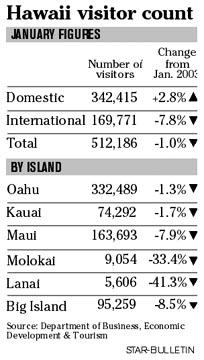
Tourism flat, with
Japan down 9.4%
Hawaii's tourism industry had a relatively flat January, though an increase in the number domestic visitors helped soften a more significant drop in the international market.
State visitor arrivals dropped 1 percent to 512,186 from 517,141 in the same month last year, with a 2.8 percent increase in domestic arrivals and a 7.8 percent decrease in international arrivals, according to figures released yesterday by the state Department of Business, Economic Development and Tourism.
An American Farm Bureau Federation convention brought 7,500 visitors to the state, increasing the meetings, convention and incentives market by 11.6 percent from the previous January.
"We are pleased to see steady growth in visitor arrivals from our primary U.S. market," said Marsha Wienert, Gov. Linda Lingle's tourism liaison. "Arrivals increased across all U.S. regions. It is also encouraging to see the improvement from our meetings, conventions and incentives visitors segment, which has continued to grow since July 2003."
Arrivals from Japan, Hawaii's largest international market, were cut 9.4 percent. The Japanese usually have a five-day holiday around the New Year, but the way the dates fell on the calendar this year, the period was shortened so that fewer visitors were able to travel, Wienert said.
While arrivals from the state's top two markets, the U.S. West and U.S. East, were up nearly 7 percent in January. Hawaii's domestic U.S. East market was particularly strong and that's a good sign, said David Carey, president and chief executive officer of Outrigger Enterprises Inc., because visitors from these regions typically spend more money and stay longer.
"Having more customers staying longer softens the blow of the loss from a year-over-year decrease in the number of Japanese visitors," Carey said, adding he is disappointed with the decline in Japanese visitors, but has heard that market will rebound by April.
Canadian visitor arrivals were down 5.6 percent in January to 31,629 from 33,520 last year.
It would be hard for Hawaii's international year-over-year visitor arrivals market not to improve significantly in the next few months, said Bank of Hawaii chief economist Paul Brewbaker, adding that SARS and the war with Iraq really begun to hurt the market last February.
"We had a good start to the year, but it really started to drop in February and April, May and June were particularly weak months," Brewbaker said. He expects the international market to rise to 14.7 percent by the year's end.
The number of cruise ship passengers was down 18.8 percent to 15,383 from 18,940 last year. The decrease was attributed to a reduction in the passenger capacity of cruise ships that toured Hawaii in January, Wienert said. There was also a decrease in the number of Hawaii homeported cruise ships, she said.
Visitors spent $851 million in January. U.S. East visitors spent $291.8 million, the most of any visitor group. U.S. West visitors spent $253.9 million. Visitors from Japan spent $160.5 million and visitors from Canada spent $60.8 million.
Japanese visitors, who averaged $254 a day in spending, continued to spend the most on a daily basis of any visitor group. While U.S. East visitors spent $160 per day; U.S. West visitors spent $136 per day and Canadian visitors spent $132 per person per day.
Visitors spent the most money on Oahu with expenditures totaling $399.4 million. Spending by visitors on Maui was second at $234.4 million, followed by visitor spending on the Big Island at $117.1 million, Kauai at $93.7 million and Molokai at $2.4 million.
Comparative data on visitor spending, length of stay and visitor days was unavailable this month as DBEDT has revised its data processing, Wienert said. The change will make monthly data on visitor expenditures available the same month as other DBEDT statistics.
In addition, information on Oahu visitors is from a new Oahu survey that began last month. A new survey format allows visitors to report their exact length of stay, instead of a range of days recorded by the old fill-in bubble format.
The new data collection and processing procedures will help the state better calculate visitor spending impacts, Wienert said.
